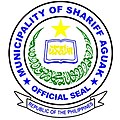Shariff Aguak Maganoy | |
|---|---|
| Municipality of Shariff Aguak | |
 Public Terminal at Poblacion | |
 Map of Maguindanao del Sur with Shariff Aguak highlighted | |
Location within the Philippines | |
| Coordinates: 6°51′53″N124°26′30″E / 6.86472°N 124.44167°E | |
| Country | Philippines |
| Region | Bangsamoro Autonomous Region in Muslim Mindanao |
| Province | Maguindanao del Sur |
| District | Lone district |
| Founded | September 11, 1963 |
| Named after | Shariff Aguak |
| Barangays | 13 (see Barangays) |
| Government | |
| • Type | Sangguniang Bayan |
| • Mayor | Akmad Baganian Ampatuan |
| • Vice Mayor | Mohamad Akmad B. Ampatuan Jr. |
| • Representative | Esmael Mangudadatu |
| • Municipal Council | Members |
| • Electorate | 17,711 voters (2025) |
| Area | |
• Total | 392.70 km2 (151.62 sq mi) |
| Elevation | 69 m (226 ft) |
| Highest elevation | 500 m (1,600 ft) |
| Lowest elevation | 13 m (43 ft) |
| Population (2024 census) [3] | |
• Total | 29,707 |
| • Density | 76/km2 (200/sq mi) |
| • Households | 5,347 |
| Economy | |
| • Income class | 3rd municipal income class |
| • Poverty incidence | 37.65 |
| • Revenue | ₱ 214.8 million (2022) |
| • Assets | ₱ 151.4 million (2022) |
| • Expenditure | ₱ 211.4 million (2022) |
| • Liabilities | ₱ 66.12 million (2022) |
| Service provider | |
| • Electricity | Maguindanao Electric Cooperative (MAGELCO) |
| Time zone | UTC+8 (PST) |
| ZIP code | 9608 |
| PSGC | |
| IDD : area code | +63 (0)64 |
| Native languages | Maguindanao Tagalog |
| Website | www |
Shariff Aguak, officially the Municipality of Shariff Aguak (Maguindanaoan: Kuta Shariff Aguak), is a municipality in the province of Maguindanao del Sur, Philippines. According to the 2020 census, it had a population of 33,982. [5]
Contents
- History
- Geography
- Barangays
- Climate
- Demographics
- Economy
- Government
- List of former chief executives
- See also
- References
- External links
It is formerly known as Maganoy.
Despite only being the de jure (by law) seat of Maguindanao's provincial government from 1973 to 1977, the town—being home to several previous governors—has served as the de facto (by practice) capital during the governorships of Sandiale Sambolawan (1980–1986), Andal Ampatuan, Sr. (2001–2008) and Sajid Ampatuan (2008–2009).




